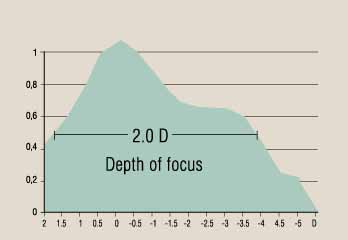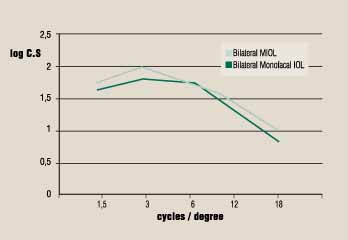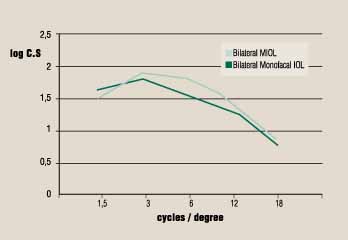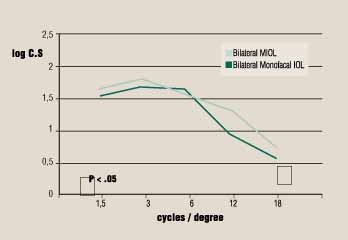Increasing the reliability of Array IOLs widens selection criteria for multifocals
Traditional ophthalmologic contraindications are no longer absolute and all patients can enjoy an enhanced quality of life.
VENICE — While multifocal IOLs are demonstrating increasing efficacy and reliability, selection criteria for this type of implant have remained far too restrictive. According to Prof. Giuseppe Ravalico, MD, surgeons should be more confident in offering this option to all cataract patients.
“We have come to the conclusion that patient selection needs to be based only on psychological criteria. In the past 2 years, we have implanted Array multifocal IOLs [Allergan, Irvine, U.S.A.] on patients with glaucoma, diabetic retinopathy, drusen and age-related macular degeneration. So many conditions that have so far been considered as absolute contraindications do not jeopardize the final results of this type of implant. In fact, they should be regarded as additional reasons to offer an option that enhances the patients’ quality of life,” he said.
 |
 |
| Figure 1: Binocular visual acuity vs. defocus curve (bilateral multifocal IOL) | Figure 2: Binocular visual acuity vs. defocus curve (bilateral monofocal IOL) |
Results
|
||||||||||||||||||||||||||||||||||||||||
At the Venice 2000 meeting, Prof. Ravalico presented the results of a study on 43 non-selected patients implanted bilaterally with the Array SA40 multifocal IOL. The mean age of patients was 67.5 years (range 24 to 90). Results were compared with those of 10 patients of similar age (mean 70.8 years; range 61 to 80) implanted bilaterally with monofocal IOLs.
“Mean corrected visual acuity for distance was 1.07±1 in the multifocal group and 0.99±0.09 in the monofocal group. In near acuity, as predicted, there was a significant difference between the values of the multifocal group (1.87±1.16) and those of the monofocal group (5.11±1.34),” Prof. Ravalico said. “Depth of focus also was significantly different. The multifocal group reported a mean of 5.5 D, against the mean of 2 D of the monofocal group [Figures 1, 2].”
Tests on fusion amplitude, aniseikonia and stereoacuity indicated a completely normal binocular function, with no statistically significant difference in the two groups. Stereoacuity for near was compared with spectacle correction in the monofocal group (Figure 3).
“It is a common belief that multifocal IOLs lower contrast sensitivity. However, our results showed that, under photopic conditions, contrast sensitivity values were within a normal range in both groups [Figures 4, 5, 6],” Prof. Ravalico said. Different values were only noted in patients with macular drusen.
Where multifocals make the difference
 |
 |
| Figure 4: Binocular distance vision contrast sensitivity (VCTS 6500, 200 lux) | Figure 5: Binocular intermediate vision contrast sensitivity (VCTS 6500, 200 lux) |
“However, conclusive evidence in favor of multifocal IOLs is the result of a questionnaire on everyday life and tasks where patients answered with a score from 1 to 100. The high scores given to all questions account for the general feeling of well-being and comfort that so many multifocal patients report,” Prof. Ravalico said. (Figure 7)
To the first general question on the degree of satisfaction, both groups assigned more than 90 marks. Activities requiring vision for distance, such as driving, reading road signs and watching TV, obtained comparably high results in both groups.
Tasks for near or medium distance, such as reading, doing fine handwork and cooking, were given significantly higher marks by patients implanted with multifocals.
Light conditions seemed to make no difference. Patients of both groups gave a high score to both scotopic and photopic activities. Color vision scored 100 in both groups.
Patients also were asked to mark the presence of halos. The answers indicate a minimal disturbance with both types of lenses.
“The most frequently reported side effect of multifocal IOLs is the vision of halos around lights and some difficulty in driving at night. However, only two of our patients considered this phenomenon disturbing. All the others are hardly bothered by it. I must say that most patients also refer to the vision of halos before surgery,” Prof. Ravalico said.
Venice 2000 was sponsored by Ocular Surgery News, the Italian Association of Cataract and Refractive Surgery and the International Society of Refractive Surgery.
 |
| Figure 6: Binocular near vision contrast sensitivity (VCTS 6500, 200 lux) |
|
||||||||||||||||||||||||||||||||||||||||||
For Your Information:
- Prof. Giuseppe Ravalico, MD, is professor of ophthalmology and head of Trieste University Eye Clinic. He can be reached at Ospedale Maggiore, 34129 Trieste, Italy; phone/fax: +(39) 040-772449; e-mail: ravalico@mail.univ.trieste.it. Prof. Ravalico has no direct financial interest in any of the products mentioned in this article, nor is he a paid consultant for any companies mentioned.
- Allergan Inc. can be reached at 2525 Dupont Drive, Irvine, CA 92612 U.S.A.; +(1) 714-246-2201; fax: +(1) 714-246-4297.
